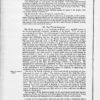
Matthew Jones, “On Nineteenth-Century Welsh Literacies, and the ‘Blue Book’ Education Reports of 1847”
This essay considers the 1847 Reports of the Commissioners of Inquiry into the State of Education in Wales, better known as the “Blue Books,” which alleged that Wales’s Welsh-speaking population was benighted, immoral, superstitious, and barbarous, and in need of English-language education. These factors were said to be compromising the country’s modernization while also, in more quiet ways, threatening British society more broadly. The Welsh language was the primary target, and it was deemed antiquated and unfit for commercial and imperial life. Through the Welsh language, the Blue Books also inveighed against Welsh motherhood, Wales’s increasing Nonconformity, and its recharged and growing literary culture. I place the Blue Books in a larger nineteenth-century Welsh context, focusing especially on how rising rates of literacy and religiosity across the country countered the Blue Books’ primary claims. I discuss with particular emphases the Welsh Calvinistic Methodist movement, the antiquarian movement, the revived eisteddfod literary festival, and the influences of Welsh women in Welsh society and as Welsh mothers. Furthermore, I argue that the Blue Books borrowed much colonialist rhetoric then in fashion that disparaged Irish, Indian, Chinese, and African people. With this in mind, the Blue Books fit in among contemporary colonial documents, and they construct the Welsh in similar manners to how other non-English populations were during this moment of Victorian Britain.
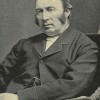
Kimberly J. Stern, “The Publication of John Pentland Mahaffy’s The Decay of Modern Preaching (1882)”
This contribution to BRANCH documents the historical and biographical conditions surrounding the publication of John Pentland Mahaffy’s controversial volume The Decay of Modern Preaching (1882). Although often deemed to be a secular or even heretical thinker, Mahaffy emerges here as a thoughtful scholar of religion standing at the crossroads of faith and reason. In the years preceding the publication of The Decay of Modern Preaching, Mahaffy witnessed a number of changes at Trinity College Dublin that threatened the principles he deemed essential both to good preaching and to intellectual culture more broadly. Mahaffy’s views on intellectual work and religion were mutually sustaining, a fact that helps to enrich our understanding of this important text, its troubled reception in the nineteenth century, and the evolving narrative of nineteenth-century faith.

Jane Stabler, “Religious Liberty in the ‘Liberal,’ 1822-23”
A survey of the negative twentieth- and twenty-first-century critical reception of the Liberal; a summary of the history of the journal and a re-evaluation of the philosophical and political coherence of the journal, focusing on its defence of religious liberty and suggesting that religious free thought is a previously overlooked component in the politics of liberalism. The criticism of doctrinal rigidity and advocacy of different forms of religious toleration evident in the four issues of the Liberal support the claim that the journal forms a lucid and intelligible cultural intervention.

Barbara Charlesworth Gelpi, “14 July 1833: John Keble’s Assize Sermon, National Apostasy”
This essay outlines the personal interactions and political events preceding John Keble’s delivery of a sermon later entitled National Apostasy to the judges gathered at Oxford for the Assize Court as a way of understanding the sermon’s significance in relation to the Oxford Movement.

Peter Capuano, “On Sir Charles Bell’s The Hand, 1833″
This essay explores the cultural context in which Sir Charles Bell’s 1833 Bridgewater Treatise was published by focusing on the work as a culmination of his deep religious faith, his Edinburgh anatomical training, and his occupation as a surgeon at the Leeds Infirmary. It argues that The Hand was not merely an extension of Paleyan natural theology but also an important response to the era’s struggle with the grim physical reality of the supersession of manual labor by automatic manufacture.
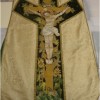
Ayla Lepine, “On the Founding of Watts & Co., 1874”
In 1874 three prominent Victorian architects founded the ecclesiastical and domestic fittings and furnishings business Watts & Company: George Gilbert Scott junior, Thomas Garner, and George Frederick Bodley. The firm was established within a cultural climate of transition. By the 1870s, the Gothic Revival and the Aesthetic Movement began to overlap and merge. Sacred and secular architectural and decorative impulses increasingly shared common traits. These aesthetic shifts were accompanied by major debates in British religious and political spheres. In the foundations of Watts and Company, beauty and labor were interlaced with religious controversy, political reform, and commercial ambition. Begun when William Morris’ own decorative arts firm, begun in 1861, underwent drastic restructuring, and in the same few months that Parliament debated High Anglican rituals, and church practices could land clerics in prison, Watts and Company’s incorporation was a bold move for the three architects. What had its roots in radicalism and avant-garde style set the tone for the establishment tastes by the end of the century
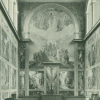
Margaretta S. Frederick, “On Frederic Shields’ Chapel of the Ascension, 1887-1910”
On 26 February 1911, the Pre-Raphaelite artist Frederic Shields (born 1833) died, having spent the last twenty years of his life devoted to the decoration of the Chapel of the Ascension in Bayswater, London. Conceived of in 1887, completed in 1910, bombed in 1944 during the Blitz of World War II and demolished in 1969, the Chapel represents changing Victorian precepts of religion and faith as well as attitudes towards public art and decoration on the eve of the modern age. Designed by the architect and aesthete Herbert Horne (1864-¬1916) and modeled on thirteenth-century northern Italian church architecture, the chapel design was a reflection of the British rediscovery of the Italian Renaissance during the Victorian period. Shields’ use of the marouflage technique, mimicking continental fresco schemes, reflects a national desire to raise public British art to a level of “high art,” which would ensure it a place in the art historical canon.
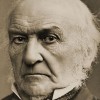
Elsie B. Michie, “On the Sacramental Test Act, the Catholic Relief Act, the Slavery Abolition Act, and the Factory Act”
Examining two sets of intertwined Parliamentary Acts that went into effect before and after the Reform Act of 1832, this entry argues that they make visible the gestures that led up to and resulted from reform.
